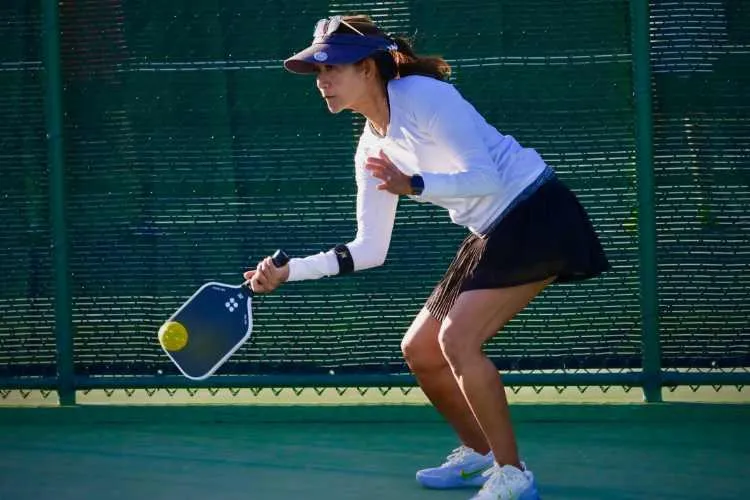

EXERCISE & FITNESS ARTICLES

Pickleball Injuries: Play Safe to Stay in the Game
Pickleball has rapidly gained popularity among people of all ages due to its accessibility and fun gameplay. However, like other sports, it comes with its risks of injury.
According to pickleheads.com, 28.8 percent of the 36.5 million pickleball players are between the ages of eighteen and thirty-four. However, in its study of pickleball-related emergency room visits, the Journal of Emergency Medicine reported that 90.9 percent of all pickleball injuries occur amongst those who are fifty years of age and older.

“Pickleball’s strength is also its greatest weakness,” said Dr. Gian Corrado, Director of Emergency Medicine at Massachusetts General Hospital and head team physician for Northeastern University. “It’s very accessible, so we’re seeing a lot of older people in the sport and a lot of weekend warriors. One prevention tip is just to be in condition.”
While pickleball is generally considered low-impact, certain injuries are common among players. Understanding these injuries and implementing preventive measures can keep you on the court, enjoying the game without setbacks. The most common injuries are listed below, but ultimately, your functional fitness level—including balance, mobility, flexibility, and endurance—will play an important role as to what injuries you may be most susceptible to.
Common Pickleball Injuries and How to Avoid Them
Shoulder Strain
The repetitive overhead swinging motion in pickleball can strain the shoulder muscles and tendons. To avoid this, warm up properly before playing, gradually increasing the intensity of your swings. Strengthening exercises targeting the shoulder muscles can also help prevent strain. Avoid overexertion and take breaks to rest your shoulder during prolonged play sessions.
Elbow Tendonitis
Known as "tennis elbow," this injury occurs when the forearm muscles are overused. To prevent this, focus on proper paddle grip and technique. Ensure that your paddle isn’t too heavy and that your strokes are executed with a relaxed grip, reducing strain on the elbow. Stretching exercises for the forearm muscles before and after playing can also be beneficial.
Ankle Sprains
Quick, lateral movements and abrupt changes in direction during pickleball can lead to ankle sprains. Wearing proper footwear with good ankle support is crucial. Doing exercises that strengthen the ankles and improve balance can significantly reduce the risk of a sprain occurring. Additionally, being mindful of your footwork and avoiding sudden, jerky movements can help prevent ankle injuries.
Knee Injuries
The repetitive nature of pickleball movements, including pivoting and lunging, can put stress on the knees. To prevent knee injuries, focus on maintaining proper form during movements. Strengthening exercises targeting the quadriceps and hamstrings can provide better support for the knees. Wearing knee braces or supportive sleeves might also be beneficial for players prone to knee issues.
Back Strain
Twisting and bending while playing pickleball can strain the muscles in the back. Engaging in core-strengthening exercises can provide better stability and support for the back. Improving posture and practicing proper body mechanics during play, such as bending at the knees instead of the waist, can also help prevent back strain.
Dehydration and Heat-Related Issues
Pickleball is often played outdoors, exposing players to the risk of dehydration and heat-related illnesses. Staying hydrated before, during, and after play is crucial. Take frequent breaks in shaded areas, wear breathable clothing, and use sunscreen to protect yourself from the sun's rays. However, be aware that dehydration can occur during indoor play, as well, so dink and drink.
Wrist Injuries
The repetitive wrist movements involved in holding the paddle and executing shots can lead to wrist strain or even tendonitis. Using the right paddle grip and technique is essential. Additionally, performing wrist-strengthening exercises and stretches can help prevent injuries.
Overtraining or playing for extended periods of time without adequate rest can lead to overuse injuries. It is essential to listen to your body and allow ample time for recovery between play sessions. Incorporating rest days into your pickleball routine and cross-training with other activities can reduce the risk of overuse injuries.
While pickleball is a relatively safe and enjoyable sport, being aware of common injuries and taking preventive measures is crucial for players of all levels. Prioritizing proper warm ups, technique, adequate rest, and overall fitness can significantly reduce the risk of injuries, allowing players to continue enjoying the game without setbacks.
Intermountain Sports Performance offers an assessment that helps determine your current level of fitness and identify muscle imbalances to create a customized exercise prescription that will take you from where you are to where you want to be. To learn more, contact Tiffany Gust at Intermountain Sports Performance by calling (435) 251-3733 or emailing [email protected]. Pickleball is a great way to stay fit and live the healthiest life possible. Remember, staying injury free means more time on the court having fun! I hope to see you there soon.
